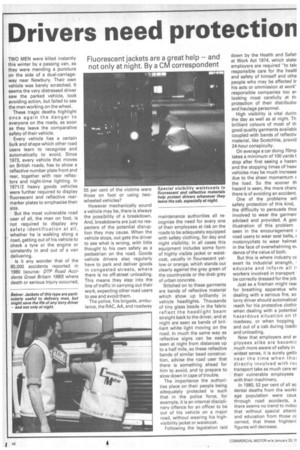Drivers need protection
Page 40

If you've noticed an error in this article please click here to report it so we can fix it.
Fluorescent jackets are a great help — and not only at night. By a CM correspondent
TWO MEN were killed instantly this winter by a passing van, as they were mending a puncture on the side of a dual-carriageway near Newbury. Their own vehicle was barely scratched. It seems the very distressed driver saw the parked vehicle, took avoiding action, but failed to see the men working on the wheel.
These tragic deaths highlight once again the danger to everyone on the roads, as soon as they leave the comparative safety of their vehicle.
Every vehicle has a certain bulk and shape which other road users learn to recognise and automatically to avoid. Since 1973, every vehicle that moves on British roads, has to show a reflective number plate front and rear, together with rear reflectors and night-time lighting. In 1971/2 heavy goods vehicles were further required to display fluorescent and reflective rearmarker plates to emphasise their size.
But the most vulnerable road user of all, the man on foot, is not required to display any safety identification at all, whether he is walking along a road, getting out of his vehicle to check a tyre or the engine or constantly in and out of a van delivering.
Is it any wonder that of the 85,000 accidents reported in 1980 (source: DTP Road Accidents Great Britain 1980) where death or serious injury occurred,
55 per cent of the victims were those on foot or using twowheeled vehicles?
However mechanically sound a vehicle may be, there is always the possibility of a breakdown. And, breakdowns are just no respecters of the potential disruption they may cause. When the vehicle stops, out gets the driver to see what is wrong, with little thought to his own safety as a pedestrian on the road. Goods vehicle drivers also regularly have to park and deliver goods in congested streets, where there is no off-street unloading. This means they step into the line of traffic in carrying out their work, expecting other road users to see and avoid them.
The police, fire brigade, ambulance, the RAC, AA, and roadway maintenance authorities all recognise the need for every one of their employees at risk on the roads to be adequately equipped with safety clothing, for day and night visibility. In all cases this equipment includes some form of highly visible jacket or waistcoat, usually in flourescent yellow or orange, which stands out clearly against the grey green of the countryside or the drab grey of urban concrete.
Stitched on to these garments are bands of reflective material which show up brilliantly in vehicle headlights. Thousands of tiny glass beads in the fabric reflect the headlight beam straight back to the driver, and at night are seen as bands of brilliant white light moving on the road. In much the same way as reflective signs can be easily seen at night from distances up to a half mile, so these reflective bands of similar bead construction, advise the road user that there is something ahead for him to avoid, and to prepare to slow down in case of trouble.
The importance the authorities place on their people being adequately protected is such that in the police force, for example, it is an internal disciplinary offence for an officer to be out of his vehicle on a major road, without wearing his highvisibility jacket or waistcoat.
Following the legislation laid down by the Health and Safeti at Work Act 1974, which state employers are required "to taki responsible care for the healtl and safety of himself and othe people who may be affected b his acts or ommission at work' responsible companies too ar looking most carefully at th protection of their distributio and haulage personnel.
High visibility is vital durin the day as well as at night. Th brilliant colours of most of th good quality garments availabl( coupled with bands of reflectiv material, like Scotchlite, provid 24-hour conspicuity.
On average a car doing 70mp takes a minimum of 100 yards t stop after first seeing a hazan and the stopping times of heav vehicles may be much increase due to the sheer momentum c the load. So the sooner th hazard is seen, the more chanc there is of avoiding an accident.
One of the problems wit safety protection of this kind, the difficulty to persuade thos. involved to wear the garmen• advised and provided. A goc illustration of this problem seen in the encouragement road users to wear seat belts, r motorcyclists to wear helmet in the face of overwhelming e). dence of the value of both.
But this is where industry cz exert its industrial strength, I educate and inform all i workers involved in transport • be correctly dressed for the job
Just as a fireman might rear for breathing apparatus wh( dealing with a serious fire, so lorry driver should autornatical reach for his protective clothir when dealing with a potential hazardous situation on tf roadway, or when hopping and out of a cab during loadii and unloading.
Now that employers and en ployees alike are becomir much more aware of safety in widest sense, it is surely gettil near the time when thoi directly involved with roi transport take as much care wl their vulnerable employees with their machinery.
In 1980, 52 per cent of all ac dental deaths from the worki age population were caus through road accidents, a there seems no trend to indicz that without special attenti and education from those cc cerned, that these frighteni figures will decrease.




































































